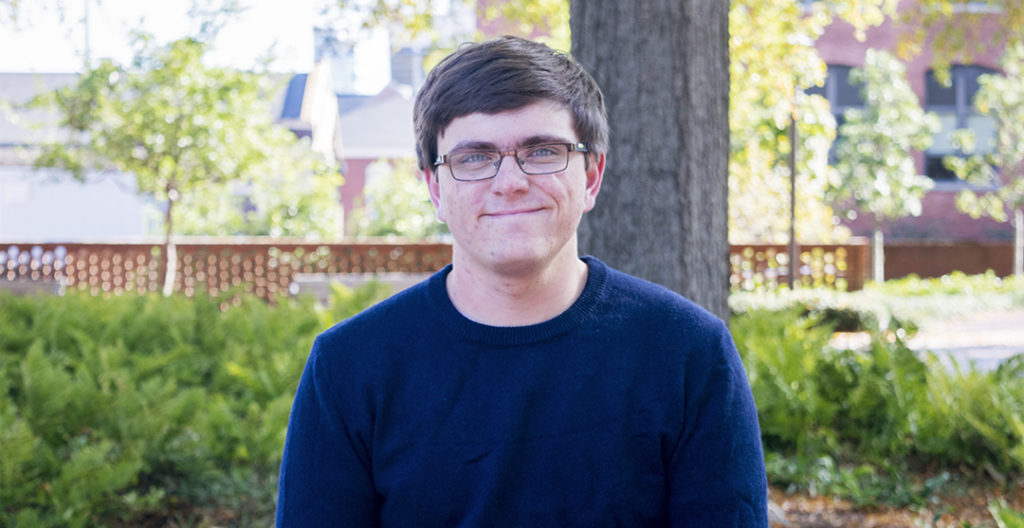Posted on 22 September 2019.

A look into the action and inaction from the Institute over the past two years
Editor’s note: A previous version of this story listed Scout’s major as chemical and biomolecular engineering. The piece has been corrected, stating their major as computer engineering.
Two years ago, Tech changed forever. On Sept. 16, 2017, Scout Schultz was shot and killed by Georgia Tech Police Department (GTPD) Officer Tyler Beck in an incident that captured national attention, ignited campus criticism and spurred discussions on changes to mental health policies on college campuses.
At the time of their death, Schultz was a fourth-year ECE student. Schultz identified as non-binary and intersex and was a champion for LGBTQIA activism in all forms. Schultz had excellent grades and was president of the Pride Alliance. But Schultz struggled with their mental health; before their death, they wrote three different suicide notes which were left in the student’s West Campus dorm.
The campus community has attempted to adapt and heal over the last two years — healing that has taken various forms with varying degrees of success. For example, GTPD armed officers with nonlethal weapons and implemented more mental health and crisis intervention training. Through partnership with vocal student leaders, Tech’s administration promised to make changes on campus; some promises have been successfully implemented, but others have lacked follow through.
Hovering in the periphery of these conversations is the hope that some sense of closure can be gained through the eventual release of the Georgia Bureau of Investigation (GBI) inquiry into the details of Schultz’s death.
The Investigation
Because Schultz died in an officer-involved shooting, many of the details surrounding their death are still unknown to the public. After the incident, the GBI collected evidence over the course of a few months and turned the case over to the Fulton County District Attorney (DA) office. The DA will make a decision on whether or not to pursue charges against Beck and if the case should be brought in front of a grand jury.
When asked if there was an update for when the DA’s investigation would be complete, a representative from the DA’s office stated: “Not at this time.”
“Myself and many chiefs in the country would like it to happen a lot quicker — for Scout’s family, for the officer, for the community,” said GTPD Chief of Police Robert Connolly.
“For it to be two years now and we still haven’t seen a grand jury case, that’s doing a disservice to everyone. We would like the grand jury a lot faster — to get to the facts, to get to the details, because you’re leaving a lot of lives out there.”
After the events of Sept. 16, 2017, Beck was placed on administrative leave while Connolly reviewed the incident based on the Georgia Department of Public Safety’s use of force policy, which states that “the central inquiry in every use of force case is whether the amount of force used by the member was objectively reasonable in light of the particular circumstances perceived by the member [officer]” (Policy 10.01.4 B).
Based on evidence that was available to him, Connolly determined that Beck had acted appropriately under the circumstances, and therefore, Beck was permitted to return to work. Beck has been performing administrative duties ever since, but does not patrol.
The Schultz family announced in a press conference on Sept. 12, 2019 that they had filed a wrongful death lawsuit against the school, the Board of Regents and Beck. They claim that Schultz was experiencing a mental health crisis and that the officers on the scene were not properly trained to handle such a situation.
“It never should have happened,” said L. Chris Stewart, an attorney representing the Schultz family. “Sadly, Scout was having a mental breakdown — something we all have sometimes.”
“No parent likes to lose a kid,” said Bill Schultz, father of Scout. “Tyler Beck killed my kid. That’s the bottom line.”
Institute relations representatives said they could not speak about the suit, citing pending litigation.
The Technique filed an Open Records Act request on Aug. 27 for information on Beck’s employment status. At the time of publishing, Institute’s legal team had not complied with the request.
The Action Teams
While waiting for the results of the investigation, the Tech community has had considerable time to identify and implement changes. The primary sources of these changes were action teams formed shortly after Schultz’s death.
“I believe that the concerns raised by the student leaders, faculty and others can be placed into four broad categories — student mental health, including a focus on both counseling and psychiatric services; campus culture; LGBT+ community issues; and campus safety,” stated an email from President Emeritus G. P. “Bud” Peterson that was sent to the campus community on Sept. 23, 2017.
“Based upon the discussions already held and those I will be having in the next few days, I will be appointing, within the week, four Institute-wide “Action Teams,” each focusing on one of these four areas.”
An update from Peterson on Oct. 2, 2017, stated that “the formation and charge of the Campus Safety Action Team has been delayed, however, pending the completion of the investigation by the Georgia Bureau of Investigation.”
The action teams were later reworked into three focus areas, under different names: student and community life, academics and health and well-being. Notably, this reorganization of the action teams removed an LGBTQIA-focused group. Together, the three teams provided more than 180 recommendations, which were distilled into 55 action-oriented objectives.
Information about the status of each objective can be found at gatech.edu/path-forward-together.
Despite the failure to form a campus safety action team, there has been progress. Among the completed objectives is an expanded LGBTQIA resource center, which moved from a small office to a full suite in the Smithgall Student Services building in August of 2018.
“Part of Scout’s mental health issues were largely part of their oppression as an intersex, non-binary, bisexual person,” said Naiki Kaffezakis, an NRE Ph.D. and close friend of Schultz. Kaffezakis, a vocal student activist, recognizes that significant improvements have been made, but she insists that more work needs to be done to ensure marginalized groups on campus are lifted up.
The center aims to provide a safe space for LGBTQIA students and runs educational programming to educate the campus community about queer lives and concerns. In addition, gender-inclusive housing is now available and single-occupancy restrooms have been implemented in 63 buildings on campus.
The mental health action team responded to calls for easier access to mental health resources by creating the Center for Assessment, Referral, and Education (CARE). The CARE center opened ahead of schedule in August 2019 and is now the first point of contact for students who require mental health support.
“Students tell us they’re proud of the rigor because you got into a really tough school and you’re getting out with a really amazing degree,” said Lynn Durham, former chief of staff for President Emeritus Peterson and current vice president of institute relations. Durham headed the action team initiative. “[The rigor] comes along with a lot of pressure. How can we get our faculty to understand the pressure that you all are under? What can we do to just be more humane in how that is?”
Efforts to adjust academic attitudes came in the form of an expanded “freshman forgiveness” that allows all undergraduate students to retake up to two classes in which they received a grade of D or F.
While other teams made strides to improve upon the areas they had identified, promises for the eventual creation of the campus safety action team never came to fruition. Peterson sent an update on Dec. 6, 2017, about the progress the teams had made; absent was any mention of the campus safety action team, and all mentions of this team were also removed from the website.
Durham stated that the team originally intended to focus on general relations between police and students, but not the events surrounding Schultz’s death. Under advisement from Tech attorneys, the administration decided to cancel the action team altogether. The student body received no update.
“People were so hurt, and it was such a traumatic event that [an action team] couldn’t help but go into that,” Durham said. “So the lawyers said that really until the legal issues are resolved on this, we don’t feel you should have the campus safety [action team].”
The Student Government
In the absence of administrative action, the Student Government Association (SGA) decided to step up and create a Campus Safety Advisory Board. The idea was brought up by the administration of Evan Gillon, former SGA President. It was implemented by Pooja Juvekar, current SGA president, and Kathryn Otte, vice president of campus services, just a few weeks ago.
The first meeting of the Campus Safety Advisory Board took place on Sept. 3; among those in attendance were Connolly, Kaffezakis, Vice President of Student Life John Stein and various student and staff representatives. The advisory board aims to eventually become the formal conduit of communication between students and other safety-related departments on campus.
“It can allow us to have an avenue to hold GTPD and administration accountable in the realm of not just what happened with Scout in 2017, but also moving forward,” said Juvekar. “It’s a way for students to basically pulse check the progress of Path Forward.”
The advisory board is still in its infancy; the first task is learning more about how GTPD is trained to handle mental health issues and identifying actionable items in order to improve campus safety in a variety of ways.
Shortly after Schultz’s death, SGA and the Institute made an agreement to create a Mental Health Joint Allocation fund. SGA and Tech would each contribute $500,000 for long-term mental health projects. This fund has been used to fund after-hours on-call counselor and student conferences, among other things. Genny Kennedy, president of Pride Alliance, indicated that her organization had submitted a proposal for funding of a memorial bench for Scout. Kennedy said that administration had failed to put up their half of the $10,000 and that Pride Alliance had to ask SGA to fund the whole thing.
“The total cost for the memorial bench is $10,000,” stated the proposal for the remaining amount that was submitted to SGA. “Of this amount, $5,000 has been secured. There has been no effort to create a positive memorial. The only physical memorial to remember Scout by is a stain on the sidewalk.”
The Police
GTPD has been quietly working over the last two years to improve their ability to handle mental health crises. Every officer has had additional training on mental health crises as well as training on LGBTQIA issues.
At the time of Schultz’s death, GTPD officers had received some mental health training. One such program is Conflict Intervention Training (CIT), which according to CIT International is intended to help officers understand common signs and symptoms of mental illnesses, recognize a crisis situation, safely de-escalate individuals experiencing behavioral health crises and utilize community resources and diversion strategies to provide assistance.
Beck, as well as several other officers who responded to the incident, did not have CIT certification, because it was not required. Each officer now has CIT training, Mental Health First Aid training and Question, Persuade, Refer (QPR) suicide prevention trainings.
Additionally, GTPD purchased a simulator with 800 different scenarios that officers are required to use at least once a month. The immersive simulator aims to put officers under realistic levels of stress and evaluate their ability to act appropriately in a variety of situations, including when an individual is undergoing a mental health crisis.
Mental health crises become more pronounced on campus around finals season, when both GTPD and Tech’s on-campus mental health resources begin to get a lot of calls from students who are struggling. In the spring 2019 semester, GTPD partnered with the Georgia Crisis and Action Line and put a clinician in the car with every officer that responded to a mental health call. Connolly said GTPD received great feedback and will continue the finals week adjustments in the future.
The Aftermath
“Scout’s friends are still here. Anniversaries are hard,” said Kaffezakis. She knows that the suit from Schultz’s family will once again bring Tech into the spotlight. “Once we have survived that, once we have answers, once we know what’s going to happen to Tyler Beck … I would like to know that the person that killed my best friend isn’t still working in this community. It’s not going to let the community heal.”
This week has been a tough one for many students, as they spent time remembering Schultz and bracing for increased media coverage. For so many whose lives were impacted by them, it is imperative that what happened to Scout Schultz is never forgotten.










